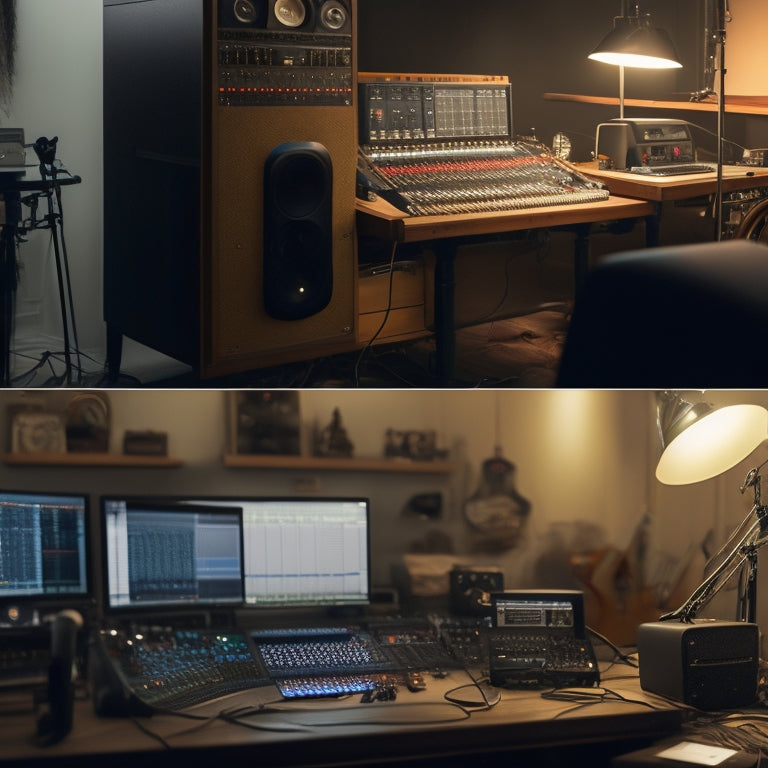
7 Essential Music Editing Tips for Performance Success
Share
Think of a song like 'Stairway to Heaven' - its iconic guitar intro sets the tone for the entire track. A well-crafted song structure is crucial for performance success, and it all starts with a solid foundation. But how can you guarantee your song flows seamlessly from intro to outro, building emotional intensity and dynamic energy along the way? By mastering the art of music editing, you'll be able to create a sonic landscape that draws listeners in and keeps them hooked. Want to learn the secrets to editing like a pro and taking your performance to the next level?
Key Takeaways
• Craft a performance-ready track with a suitable song structure, balancing repetition and variation for audience engagement.
• Use mixing techniques to balance volume levels, creating contrast and intrigue, and pay attention to stereo imaging for correct panning.
• Strategically place sound effects to immerse the audience, exploring techniques like reverb, distortion, and layering to enhance mood and atmosphere.
• Experiment with tempo adjustments to inject a fresh perspective, creating rhythmic variations for complexity and interest.
• Prioritize lossless formats like WAV or AIFF to preserve audio integrity, ensuring edited tracks sound crisp and clear.
Choose the Right Song Structure
When crafting a performance-ready track, select a song structure that complements the emotional arc of your lyrics and the energy of your melody. This foundation will help you create a cohesive and engaging listening experience.
You'll want to balance repetition and variation to keep your audience invested. A well-planned verse progression is key to achieving this balance. Experiment with different chord progressions to create a sense of tension and release, drawing your listener through the narrative of your song.
Effective chord exploration can elevate your melody and add depth to your lyrics. Consider the mood and atmosphere you want to evoke, and choose chords that support your vision. By thoughtfully selecting your song structure, you'll set yourself up for success and create a performance-ready track that resonates with your audience.
Edit for Seamless Transitions
Craft seamless connections by paying attention to the musical elements that bridge sections, ensuring a cohesive flow that keeps your audience engaged throughout the performance. To achieve this, you'll need to focus on handoff points, where one section ends and another begins. This is where crossfade techniques and beat matching strategies come into play.
| Handoff Technique | Description |
|---|---|
| Crossfade | Gradually fade out one section while fading in the next, creating a smooth overlap |
| Beat Match | Align the tempo and rhythm of adjacent sections, ensuring a seamless handoff |
| Phrase Matching | Match the ending phrase of one section to the starting phrase of the next, maintaining musical flow |
| Energy Matching | Balance the energy levels of adjacent sections, avoiding abrupt changes |
Create a Dynamic Volume Balance
You'll need to balance the volume levels of different sections to create a dynamic performance that takes the audience on a sonic journey. This is where the art of mixing comes in.
A well-balanced mix is all about creating a sense of contrast and intrigue, taking the audience through a range of emotions. To achieve this, you'll need to master the frequency response of each instrument, making sure each one has its own space in the mix. Pay attention to the low end, where the bass and drums reside, and the high end, where the cymbals and percussion live.
When balancing levels, keep an ear out for stereo imaging, making sure each instrument is panned correctly in the mix. A good rule of thumb is to keep the core elements, like the vocals and rhythm section, centered, while the peripherals, like guitars and keyboards, are panned to the sides.
Add Emphasis With Sound Effects
When you add sound effects to your music, you're not just adding noise - you're crafting a sonic landscape that immerses your audience.
By strategically placing sound effects, you can create drama and tension, or evoke a specific mood and atmosphere.
Sonic Landscapes Created
By strategically incorporating sound effects, you can transport your listeners to immersive sonic landscapes that elevate the emotional impact of your performance. This is achieved by manipulating audio elements to create a rich, textured soundscape that envelops your audience.
To craft a compelling sonic landscape, explore frequency ranges to create depth and dimension. Utilize frequency exploration to allocate space for each instrument, allowing them to breathe and shine. Next, experiment with texture manipulation to add complexity and interest. Consider the following techniques to enhance your sonic landscape:
| Technique | Description | Effect |
|---|---|---|
| Reverb | Adds space and ambiance | Creates sense of distance |
| Distortion | Alters tone and timbre | Adds grit and aggression |
| Filtering | Modifies frequency response | Creates dynamic interest |
| Layering | Combines multiple sounds | Increases texture and depth |
| Panning | Places sounds in space | Enhances spatial awareness |
Drama and Tension
As you craft your sonic landscape, strategically introducing sound effects can amplify drama and tension, drawing your audience into the performance. By incorporating sound effects, you can create a sense of building anticipation, keeping your audience on the edge of their seats. This can be achieved by using a combination of subtle and intense sound design elements, such as eerie ambient pads, creaking doors, or ominous footsteps.
To maximize emotional resonance, consider using sound effects that evoke a visceral response, such as a sudden crash or a haunting whisper. By doing so, you can create a sense of unease or uncertainty, keeping your audience invested in the performance.
It's crucial to balance the level of intensity, ensuring that the sound effects complement the music rather than overpower it. By striking the right balance, you can create a gripping sonic landscape that draws your audience in and refuses to let go.
Mood and Atmosphere
You can dramatically enhance the mood and atmosphere of your performance by strategically incorporating sound effects that evoke a specific emotional response, such as eerie ambiance, haunting melodies, or uplifting fanfares. By doing so, you can create a rich sonic palette that immerses your audience in the emotional landscape of your music.
To achieve this, consider the emotional resonance you want to convey and select sound effects that align with that intention. For instance, a horror-themed performance might incorporate creepy ambient textures, while a romantic ballad might feature soft, soothing soundscapes.
When selecting sound effects, pay attention to their frequency content, dynamics, and spatial placement to create a cohesive and engaging atmosphere. Remember, the key is to strike a balance between subtlety and impact, ensuring that your sound effects enhance the mood without overpowering the music.
Make Cuts for Dramatic Impact
When crafting a performance, strategically placed cuts can elevate the emotional intensity of a song, making it imperative to identify key moments where a well-timed edit can amplify the dramatic impact.
By doing so, you'll create rhythmic surprises that keep your audience engaged and invested in the music. A well-placed cut can also trigger emotional releases, allowing the listener to connect with the music on a deeper level.
To achieve this, focus on identifying sections where the energy shifts or changes tone. These moments often signal a natural breaking point, where a cut can enhance the emotional impact.
Look for opportunities to create contrast, such as moving from a soft verse to a loud chorus or from a slow section to a fast one. By cutting away at these moments, you'll create a sense of tension and release, drawing the listener in and keeping them invested in the performance.
Experiment With Tempo Adjustments
Tempo adjustments can inject a fresh perspective into your performance, allowing you to rebalance the energy and create a more engaging listening experience. By experimenting with tempo, you can create rhythmic variations that add complexity and interest to your music. This, in turn, can enhance the emotional resonance of your performance, drawing your audience in and holding their attention.
To get started, try slowing down or speeding up specific sections of your track to create contrast and add drama. You can also experiment with gradual tempo changes to build tension or create a sense of anticipation.
Remember to listen carefully to the impact of each adjustment, as even small changes can significantly modify the mood and feel of your performance.
Pay Attention to Audio Quality
By achieving peak audio quality, you guarantee that your tempo adjustments and rhythmic variations shine through, unencumbered by distortion, hiss, or other unwanted artifacts that can mar an otherwise compelling performance. As you refine your editing skills, bear in mind that audio quality is vital for conveying your artistic vision.
When working with digital audio, it's important to grasp the significance of Bit Rate and Sample Rate. A higher Bit Rate ensures a more accurate representation of your audio signal, while a suitable Sample Rate captures the full frequency range of your performance. Aim for a minimum of 44.1 kHz Sample Rate and 16-bit Bit Rate for professional-grade audio.
Avoid sacrificing audio quality for the sake of convenience or file size reduction. Instead, prioritize lossless formats like WAV or AIFF to preserve the integrity of your audio. By doing so, you'll ensure that your edited tracks sound crisp, clear, and true to your artistic intent.
Frequently Asked Questions
How Do I Avoid Over-Editing and Preserve the Original Feel?
To avoid over-editing and preserve the original feel, you'll want to strike a balance between creative freedom and sonic integrity, recognizing when to restraint your edits to maintain the emotional authenticity of your performance.
Can I Edit Music for Live Performances Using a Laptop?
You can edit music for live performances using a laptop, but optimize it first by closing unnecessary apps, updating software, and investing in a portable studio setup for a seamless, safe, and reliable show.
What Software Is Best for Beginners to Start Music Editing?
You're prepared to immerse yourself in music editing; begin with user-friendly software like Ableton Live, FL Studio, or Logic Pro, which offer tutorials and support for beginners, ensuring a safe and smooth learning curve, especially with an Audio Interface and basic Music Theory knowledge.
How Much Time Should I Allocate for Music Editing per Track?
When allocating time for music editing per track, you'll want to take into account your editing goals and studio workflow. Aim to spend at least 2-3 hours per track, but adjust based on complexity and your desired level of polish.
Are There Any Music Editing Techniques Specific to Certain Genres?
"Like a master chef seasoning a dish, you'll want to tailor your editing techniques to the genre. For instance, in EDM, use genre-specific EQ to boost bass frequencies, while in R&B, prioritize vocal-centric mixing to make the singer shine."
Related Posts
-

10 Best Time-Saving Hacks for Busy Makeup Artists
You're no stranger to the chaotic world of makeup artistry, where every minute counts. To maximize your time, start b...
-

5 Best Free YouTube Dance Makeup Tutorials
You're ready to elevate your dance performances with stunning makeup looks, and we're here to help! Our top 5 free Yo...
-

What Are the Most Popular Contemporary Costumes Right Now
Right now, popular contemporary costumes blend creativity with current trends, allowing you to showcase your unique f...


